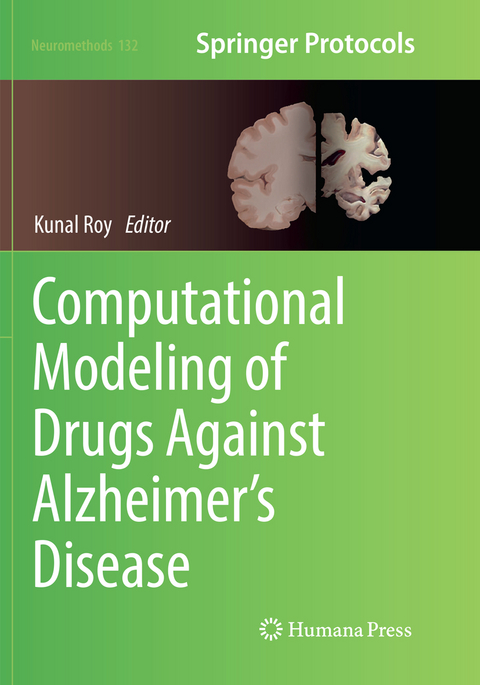
Computational Modeling of Drugs Against Alzheimer’s Disease
Humana Press Inc. (Verlag)
978-1-4939-8475-6 (ISBN)
Cutting-edge and authoritative, Computational Modeling of Drugs Against Alzheimer’s Disease is a valuable resource for learningabout the latest computational techniques used to study this disease.
Dr. Kunal Roy is a Professor in the Department of Pharmaceutical Technology, Jadavpur University, Kolkata, India. He has been a recipient of Commonwealth Academic Staff Fellowship (University of Manchester, 2007) and Marie Curie International Fellowship (University of Manchester, 2013). The field of his research interest is QSAR and Molecular Modeling with application in Drug Design and Ectoxicological Modeling. Dr. Roy has published more than 250 research papers in refereed journals (current SCOPUS h index 35). He has also coauthored two QSAR related books, edited two QSAR books and published ten book chapters. Dr. Roy serves in different capacities in the Editorial Boards of several International Journals.
Alzheimer’s Disease Therapy: Present and Future Molecules.- Recent Advances in Computational Approaches for Designing Potential Anti-Alzheimer’s Agents.- Computer-Aided Drug Design Approaches to Study Key Therapeutic Targets in Alzheimer’s Disease.- Virtual Screening in the Search of New and Potent Anti-Alzheimer Agents.- Molecular Field Topology Analysis (MFTA) in the Design of Neuroprotective Compounds.- Galantamine Derivatives as Acetylcholinesterase Inhibitors: Docking, Design, Synthesis, and Inhibitory Activity.- Modeling of BACE-1 Inhibitors as Anti-Alzheimer’s Agents.- Design of Anti-Alzheimer’s Disease Agents Focusing on a Specific Interaction with Target Biomolecules.- Molecular Docking and Molecular Dynamics Simulation to Evaluate Compounds that Avoid the Amyloid Beta 1-42 Aggregation.- In Silico Strategies to Design Small Molecules to Study Beta-Amyloid Aggregation.- Computational Approaches to Understand Cleavage Mechanism of Amyloid Beta (Aβ) Peptide.- Computational Modeling of Gamma-Secretase Inhibitors as Anti-Alzheimer Agents.- Molecular Modeling of Tau Proline-Directed Protein Kinase (PDPK) Inhibitors.- Computational Modeling of Kinase Inhibitors as Anti-Alzheimer Agents.- Computational Modeling of Drugs for Alzheimer's Disease: Design of Serotonin 5-HT6 Antagonists.- Computational Modeling of Diagnostic Imaging Agents for Alzheimer's Disease: Molecular Imaging Agents for the In Vivo Detection of Amyloid Plaques in Alzheimer’s Disease.- Computational Approaches for Therapeutic Application of Natural Products in Alzheimer’s Disease.- In Silico Studies Applied to Natural Products with Potential Activity against Alzheimer’s Disease.- Computational Modeling of Multi-Target Directed Inhibitors against Alzheimer's Disease.- Neuropharmacology in Flux: Molecular Modeling Tools for Understanding Protein Conformational Shifts in Alzheimer’s Disease and Related Disorders.- Computational Nanotechnology: A Tool for Screening Therapeutic Nanomaterials against Alzheimer's Disease.
| Erscheint lt. Verlag | 10.8.2018 |
|---|---|
| Reihe/Serie | Neuromethods ; 132 |
| Zusatzinfo | 158 Illustrations, color; 64 Illustrations, black and white; XVII, 645 p. 222 illus., 158 illus. in color. |
| Verlagsort | Totowa, NJ |
| Sprache | englisch |
| Maße | 178 x 254 mm |
| Themenwelt | Medizin / Pharmazie ► Studium |
| Naturwissenschaften ► Biologie ► Humanbiologie | |
| Naturwissenschaften ► Biologie ► Zoologie | |
| ISBN-10 | 1-4939-8475-6 / 1493984756 |
| ISBN-13 | 978-1-4939-8475-6 / 9781493984756 |
| Zustand | Neuware |
| Informationen gemäß Produktsicherheitsverordnung (GPSR) | |
| Haben Sie eine Frage zum Produkt? |
aus dem Bereich


